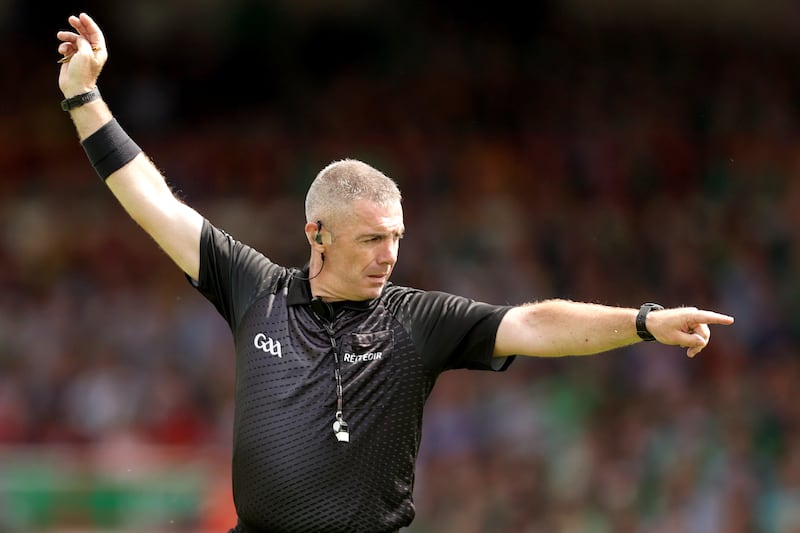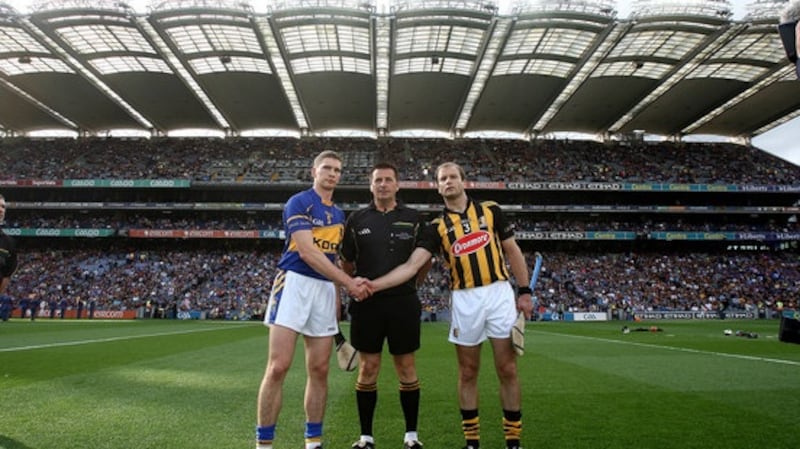Exhibit A: a random sample. About nine minutes into the Munster hurling final there were four fouls in the space of 11 seconds. One of them was a late shoulder into the chest of a player who had spilled the ball; the other three infringements involved pushing and pulling at the arms and upper body of a player in possession. Nobody went down, nobody stopped, nobody looked for a free, nobody batted an eyelid. Man and ball kept moving, as if nothing had happened.
Maybe nobody noticed except the referee. After the third or fourth infringement Liam Gordon raised his arm to indicate that he was playing an advantage, trying not to interfere, but conscious that he was the regulator. By then Ryan Taylor had escaped the sniper’s alley and was running loose in open field.
By the time he found Shane O’Donnell with a pass, Gordon had lowered his arm. Just before he drove the ball over the bar O’Donnell was fouled too, but the score stood. No free. The fouls were blended into the sauce of a hot dish; nobody cared if they were eating chilli or capers, and nobody was bothered about allergies.
Barry Kelly, the former intercounty referee, was in Croke Park, watching the Munster final on the big screen in the stadium, sitting alongside a bunch of other retired referees.
Shefflin trying to devise a way for Galway to halt Limerick juggernaut
Malachy Clerkin: The GAA should make more of St Patrick’s Day - and more of its intercounty stars
Munster CEO defends broadcast coverage of province’s hurling championship
Sports Review 2023: Murphy’s incredible reflex save showed hurling’s facility for the impossible
“One of them just said to me, ‘It’s much tougher than it was – four of five times tougher than it was [to referee an inter county hurling game]’. It’s only nine years since my last All-Ireland final [2014] but it was a joy to referee. I did three semi-finals with Galway and Tipp in 2015, ’16 and ‘17, all one point games, and they were fantastic matches [to referee]. That’s only six years ago.
“There was more mano-a-mano stuff, even then. Now, the play is condensed. There’s far more physicality, there are far more hits, the possession game has gone to a new level. For years, among the national referees, we used look on at whatever the opposite of envy is at the football referees and what they were refereeing. Dog eat dog stuff. I would think now that football has gone very passive and very lateral. A hurling game at the highest level now is as hard if not harder to referee than a game of football – and I would never have said that.

“I got loads of texts about Liam Gordon not awarding the free [to Clare in the last minute] and my stock answer was, ‘I do not envy anybody trying to referee modern day hurling’. The standard of hurling is phenomenal, the skill levels are gone off the scale, but it’s a far, far harder game than I refereed.”
Intercounty referees are sent a rule book at the beginning of the season, but up to a couple of years ago they used to receive an exhaustive 80 page handbook. One page was devoted to a checklist of match-day logistics, alpha to omega. Among the 23 items listed was a reminder to bring a coin for the toss and a straight-faced directive to “referee the game in accordance with the rules”.
But how, exactly? The way hurling is being played at elite levels has changed so much over the last five or six years that the rule book hasn’t been able to keep up. The body-shape of players, the emphasis on power-plays, greater clustering in the middle third, the prevalence of swarm tackling and the viral spread of rucks have made elements of the game impossible to referee except by gut reaction and guessing.
In a ruck, when there are half a dozen players hunched like workmen over a manhole, how is a referee supposed to decipher which player made the first illegal contact? In those situations nobody is making a shoulder charge, hip to hip, which is the only physical tackle defined in the rule book. But everybody is doing something to shift somebody else out of the way. So, does the referee allow the ruck to play itself out, knowing full well that infringements are taking place?
“Apply the rules, that’s fine,” says Willie Barrett, who was an intercounty referee for nearly 20 years, and mentors elite referees now.
“But then, let’s see what everyone is talking about on Monday morning? The number of frees. No one wants to see a situation where there are 50 or 60 frees in a match. No referee wants to be the centre of attention. Striking a balance is challenging, to say the least.”
It was easier when most duels for the ball were just between two players, and the ball spent more time in open dispute. In that environment, hooking, blocking and flicking were clean and dynamic ways for possession to change hands. Those skills, though, have been marginalised. Players are so conditioned to recycle the ball in tight situations now that throwing it up and swinging hard is the last thing on their minds. Most strikes on the ball are made in space, after a quick set-up, like the spike in volleyball.
In other situations, players are drilled to run at opponents and break the tackle. But what kind of “tackle” are they breaking? It is not a foul to meet an oncoming player with an outstretched arm, but it is a foul as soon as that arm makes a holding motion. Most players will not be stopped by that kind of contact, and because they can usually break through, the referee will ordinarily not blow for a foul.
In that way an infringement has entered the bloodstream of the game, championed by common practice. Coaches and players know that this boundary has been pushed so that kind of tackling is coached now: players are met with body hits and strong arms to the upper body in the hope of slowing them down, or forcing a turnover.
“If somebody is running at you, what options do you have?” says Dickie Murphy, the former intercounty referee. “If you go to the rule book you have the shoulder-to-shoulder or the flick. But there’s very little. The tackle that a fella is breaking, is it a legal tackle? Probably not. At times it’s like rugby with hurls. But if you start blowing for everything it gets on everyone’s nerves.”
In that kind of contact zone, the risk for the player in possession is to be accused of charging.
“You watch the warm-ups before games and in a lot of cases there’s charging going on,” says Johnny Ryan, the Munster referees co-ordinator and a former intercounty referee. “They’re taking the ball into contact and they’re charging.”
The way the game is played now requires a lot of consent. If players weren’t prepared to absorb the hits and carry on, the game would descend into anarchy. More than that, players don’t expect full protection from the rules. They understand that hurling, at elite level, is played in a blurred area between permissiveness and policing.

Brian Gavin stepped down from intercounty refereeing in 2017, partly because of the direction the game was taking at elite level. Without being a slave to the whistle, his style was to let the game flow. That took intuition and confidence and fine judgement. That approach wasn’t in the manual, but most players liked it and a lot of the time it worked. In the modern game, though, he wondered how it would fly.
“You have to be able to reel it out and reel it back,” he says. “You can only let it go when you feel you’re in control of the game and you get that vibe. A lot of referees don’t get that vibe because they don’t have that natural instinct. I could nearly know when a game was getting out of control.
“But no way would the modern game suit my style of refereeing. It just became very difficult. You could have eight or ten lads around the ball. Some plays were just impossible to ref. It wouldn’t suit me now.”
When big calls are missed in real-time by referees the question of television match officials often comes up. Professional soccer and rugby have learned to lean on that technological crutch, and the GAA have taken a tentative step down that road with Hawkeye in Croke Park and Thurles.
In his speech to GAA Congress in February the GAA president Larry McCarthy announced the formation of a work group that would explore the practicalities of such an approach in the GAA. He chose his words carefully, cautioning that the “the free-flowing nature of hurling and football may be less conducive to the use of technology than more stop-start sports”. Still he was prepared to take a look.
Johnny Ryan is on that committee. In recent weeks the work group used the Dublin-Kildare game in Nowlan Park as a field exercise, and he will be in the Gaelic Grounds tomorrow in the same capacity for the Mayo v Cork game, watching the game from screens in the TV production van.
One of the key issues is the scale of the coverage. For the Champions League final last week, for example, there were 49 cameras in use; for the Champions Cup final in rugby there were 36 cameras; for the URC final there were 33.
For the All-Ireland finals in Croke Park, though, there are just 13 cameras, and for normal live broadcasts around the country that number falls to between seven and nine.
GAAGO are covering the Offaly v Tipperary game in Tullamore today with just one main camera and a couple of roving cameras. That level of coverage would be insufficient to support a Television Match Official. The work group will bring a report to the last Central Council meeting of the year, but these are baby steps towards something that might never happen.
In any case, that won’t change how hurling is played now or refereed. Will there be rule changes? What rules? And in that case, would there be more frees? Does anybody want more frees? Only if you’re a point down in the last second.
The high wire act continues. Don’t look down.






